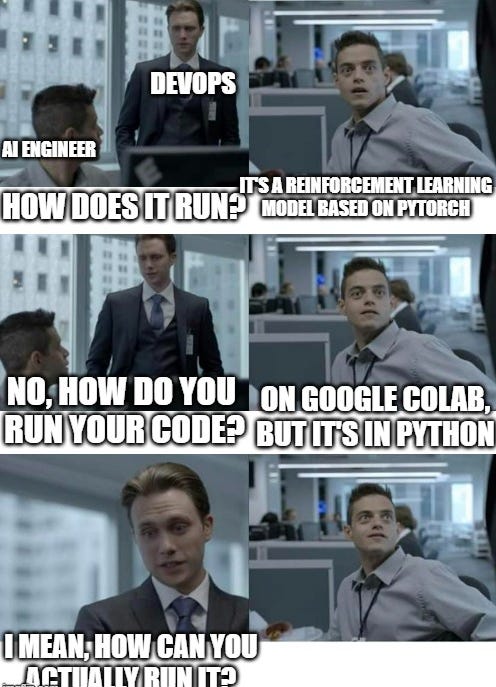Just Ship It [001/x]
Another year, another startup
Link to next post in the series.
About Me
I left the startup I was working for one week ago. I’m starting my own (again) and will build it in public. This is my founder’s diary: gathering customer feedback, finding the wedge product, getting first customers, and hiring. I’ll post Wednesdays & Saturdays.
I’ve run 3 startups and carried DevOps, DX (developer experience), and ML infra from pre-seed to Series C for many others. Making AWS, AZU, GCP, Pulumi, Terraform, and ML boring and reliable is what I’m very good at according to people I’ve worked with.
The Problem
As capabilities for writing code accelerate, the need for observability, environment parity, deployment, and debugging grows proportionally. One day, out of the blue, feature velocity plummets, the app becomes unstable, and fixes (to bugs that you should’ve detected before your biggest customer told you about it) take forever.
There are excellent hosted and open-source solutions for all of those. Deploying and implementing them to enable tracing, telemetry, deployments, monitoring, alerting, and analytics is hard. It’s cross-company code, infra, and tech debt duplication.
The Customer
Series A and beyond startups. They all have a lot in common, including a strong bias toward action. Taking on calculated tech debt to secure ARR is the correct choice. The consequences of that choice catch up as teams scale from ~5 to 10+ engineers.
Past Attempts
Per the recent MIT study, ~95% of AI implementations fail. This is true for most tech purchases that need implementation whereas those that don’t mostly succeed. The lesson is that joint ownership doesn’t work. Single responsible party = success.
UI‑first PaaS blurs ownership and makes edge cases impossible. Well designed GitOps components have clear ownership boundaries, avoid vendor lock-in, and handle edge cases by giving us the ability to fall back to Terraform and Pulumi whenever necessary.
The Solution
My job has always been to make the other engineers’ jobs mostly business logic. I’m productizing that. Pure GitOps - no fancy UIs that blur ownership boundaries, kill the ability to deal with edge cases, and take forever to build while delivering zero value.
I’m building a framework of components that are SOC2/HIPAA/etc ready* and retain the ability to handle edge cases. They just work together, come with app integration code, playbooks for zero-downtime deployment, managed upgrade PRs, SLAs, and built-in observability that covers common use cases from serverless to Kubernetes.
* For transparency: this is being built so we can retrofit compliance. The promise being made is that making the components themselves compliant will not require customer-side code changes. Updating them, testing them, and getting them certified is for later.
The Wedge
Imagine adding session replay that correlates user clicks to every API and database call emitted by them to your React application in 2-5 days. That includes deploying self-hosted OpenTelemetry, PostHog, Langfuse, and code to tie all of them together into your app. Success looks like going from sign-up to production in 2-5 days.
Crystal clarity in ownership means a milestone-based definition of “done”. You don’t pay for access to infrastructure as code - you pay to have it working in your app.
Defensibility
I’m posting the plan because this isn’t a "I’m a VC, I’ll bankroll my friend” problem. As Chainguard (love those guys!) aptly puts it: this shit is hard. Professional services don’t scale and very few people have the knowledge and experience to do this properly.
This isn’t “move fast and break things”. A single mistake brings down production for a customer and destroys all trust. AI-assisted test generation and code upgrades will be needed to maintain this and make sure it works in all 3 cloud providers for K8S-native and cloud-native deployments. In that sense, this post can be considered a pitch deck.
What’s Next
I find the first 1–10 paying design partners. Want to self-host complex, distributed OSS software that normally requires a dedicated DevOps team? Book me on Calendly or reach out via LinkedIn with “Hey, we run [docker] on [aws] and want [langfuse]!”.
The first few customers will be design partners. Your input will be heavily weighted for roadmap prioritization and you will essentially have me as a dedicated DevOps engineer for a fraction of the cost. I greatly value my reputation and won’t be taking on more customers than I can properly serve. This will scale slowly, but it’ll scale right.
When it comes to infrastructure, reliability (aka quality) is everything.


